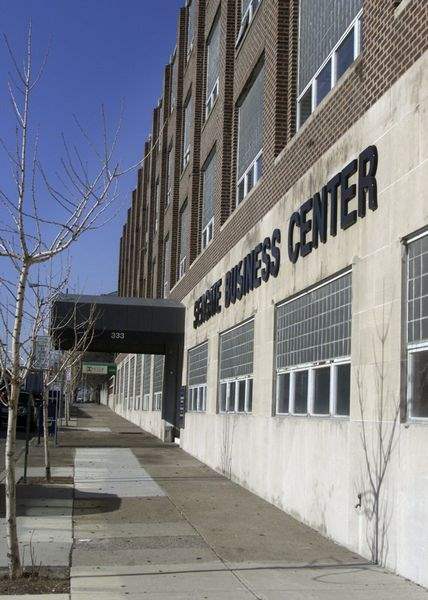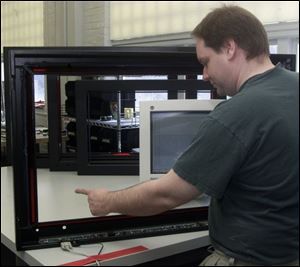
Where area tech visionaries can spread wings
4/6/2003
The building on 14th Street near downtown originally was a Willys Overland showroom.

The building on 14th Street near downtown originally was a Willys Overland showroom.
When the Research Triangle Park area of North Carolina got off the ground nearly 40 years ago, it had humble beginnings.
``We are the humble beginnings in Toledo,'' said Ronald Soka, referring to his company, Cooling Technologies Inc., and more than a dozen others that occupy the Seagate Business Center at 333 14th St.
One probably couldn't get any humbler.
Most of the “firms” that occupy the four-story building, originally constructed as a showroom for Willys Overland vehicles, are one-to-three-person businesses functioning sparsely on start-up money. Many may not survive to realize their founders' visions.
But the purpose of a business incubator like the Seagate Business Center isn't to guarantee success to every entrepreneur. Rather, it provides a place to start with access to ancillary services, obtain expertise, and gain time to grow.
``Will everybody make it here? No. Will most of them make it? Probably not,” said Brian Friedman, president of ABR Infocom, which owns the 107,000-square-foot building.
``It's a diverse group, but they're all doing the exact same thing: They're trying to make their dreams come true.''
The tenants of the Seagate Business Center are an eclectic bunch, although not all are technologically oriented.
Assets Toledo, a nonprofit group funded by Mennonite investors, offers a 13-week course for entrepreneurs that assists with business plans and marketing.
Much of the first floor is leased by the Paul Laurence Dunbar Academy, a performing-arts charter school. BNPC Inc., which makes Zippers alcohol gelatin shots, has offices and manufacturing facilities on the third floor, as does the Union of Needletrades, Industrial & Textile Employees.
The rest of the second, third, and fourth floors of the Seagate Business Center are home to fledgling high-tech firms, courtesy of the Thomas Edison Center for Technology Commercialization - a state-sponsored business incubator that moved into the building in 1999 after a lack of space forced it off the University of Toledo campus.
When it moved downtown, the center brought one start-up company with it: Mr. Soka's Cooling Technologies, which produces gas-fired air conditioning units. ``We're technically a graduate of the incubator now,'' he said.
The firm is ready to commercialize its product but needs more money to help do so, he added.
Imaging Systems Technology Inc. is considered the incubator's other graduate. It develops touch-screen systems for interactive displays, such as at malls, museums, and building entrances.

Dan Wedding tests a touch-screen at Imaging Systems Technology Inc., considered one of the incubator's graduates.
Twelve other fledgling firms have come to the Seagate Business Center since 1999, and nearly all have the same high-tech feel and hope to be the next success story. Many are close to achieving that goal.
For example, Intelligent Quality Systems designs and manufactures electronic, optical, and mechanical process-control and monitoring equipment that a factory might use to detect if an item on a production line is defective.
Coleman Systems designs automated control systems for waste water and waste treatment plants, and Non Contact International makes imaging devices that monitor the thickness of plastic and glass packaging during the manufacturing process.
Effective Matrix uses sensors and software to create a working 3-D image of a manufacturing plant floor; Light Works makes optical and opto-mechanical devices that can be used to scan objects on an assembly line, and AvantGarde Technology makes equipment to help machines “see” and measure objects on processing lines, such as packaged foods, windshields, paper, and stemware.
WeatherGlobe Technologies has been an incubator tenant for three years and could be next to graduate. It provides real-time Doppler radar weather images for wireless Internet connections, usable by boaters and others needing instant weather data.
WeatherGlobe president Jim Harpen said he didn't know how to start a business, so the incubator was a good place. ``It's a good atmosphere if you're an entrepreneur, because there's a lot of advice you can get here and there's a lot of commiserating you can do here too,'' he said.
Most businesses in the incubator have three to six employees and occupy 2,000 to 2,500 square feet. They pay rent of about $8 a square foot, including utilities and some services, but some costs are subsidized by a $182,000-a-year state grant.
A priceless benefit, though, is the synergy between the tenants, said Dennis Williams, Center for Technology Commercialization president.
``There are a lot of former [Owens Illinois] technologists here,” he said. “You could say they all came home to roost.''
Five companies in the center have teamed up to form a group called Electro Optics to develop control systems and devices to scan assembly lines for quality control.
The center's crown jewel is the $1.2 million “clean room” built in the mid-1990s for Pico Systems, a company that made parts for NASA.
With a highly purified air filtration system that provides conditions suitable for computer assembly and biotech research, the room is perfect for the manufacturing of a technology known as micro-electro-mechanical systems, or minuscule computer chips for uses such as smarter airbags in cars.
That tiny-chip work is a field ready to explode, said entrepreneur Chris Melkonian, who has created Midwest Micro Devices, which he hopes to have operating by the end of the year in the Seagate center, providing he finds financial backing.
The University of Michigan in Ann Arbor is one of the top research sites in the nation for his field, but Ann Arbor has no production facilities. The potential to use the clean room in the Seagate Business Center to make the chips has Mr. Melkonian excited. He said he knows people in Ann Arbor interested in using Toledo for the production.
But the costs of running the clean room are high - about $100,000 for electricity annually.
Mr. Friedman, owner of the center, said help for entrepreneurs is available through the federal New Markets Tax Credit program, which provide a 39 per cent tax break over a seven-year period to individuals or companies that invest in community development organizations in regions or communities designated as low-income.
Neighborhoods in Partnership Inc., a nonprofit group dedicated to renewing areas of the city that become run down, recently became eligible to apply for the next round of those tax credits, which will total about $3.5 billion nationwide.
If it receives the tax credits, Mr. Friedman said, he could use the program to attract money for the Seagate Business Center, some companies there, or both. The building could be used as collateral, he said.
Meanwhile, he said, the incubator has two pressing issues: Keep the tenants viable and develop more graduates.
``Basically, we've got to show we have users that can pay the rent,'' he said.